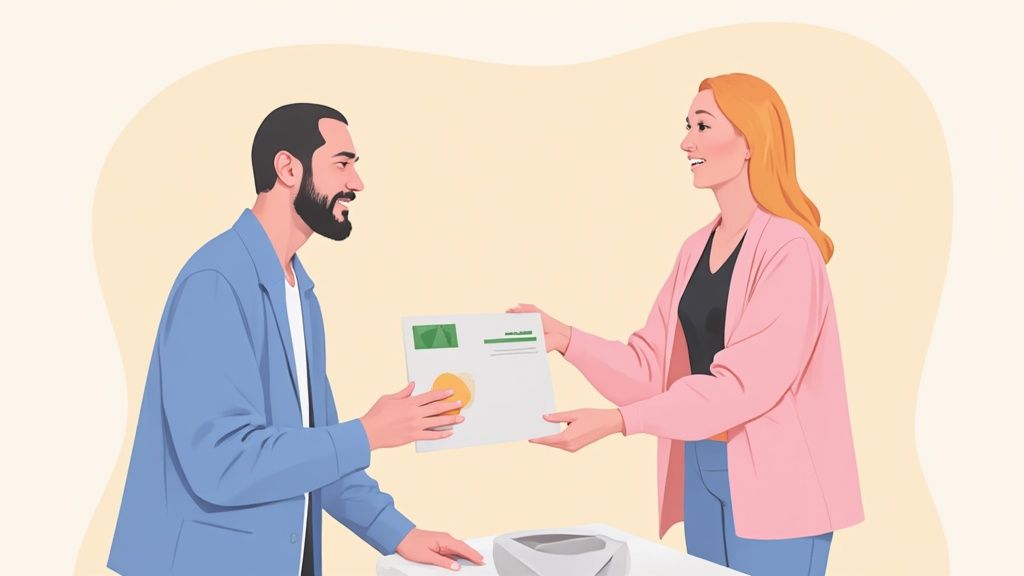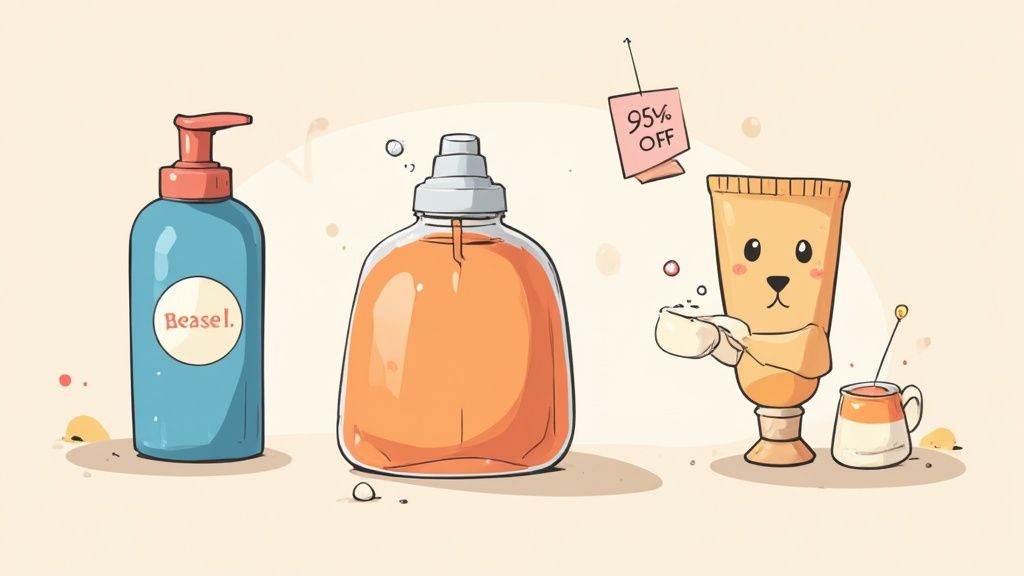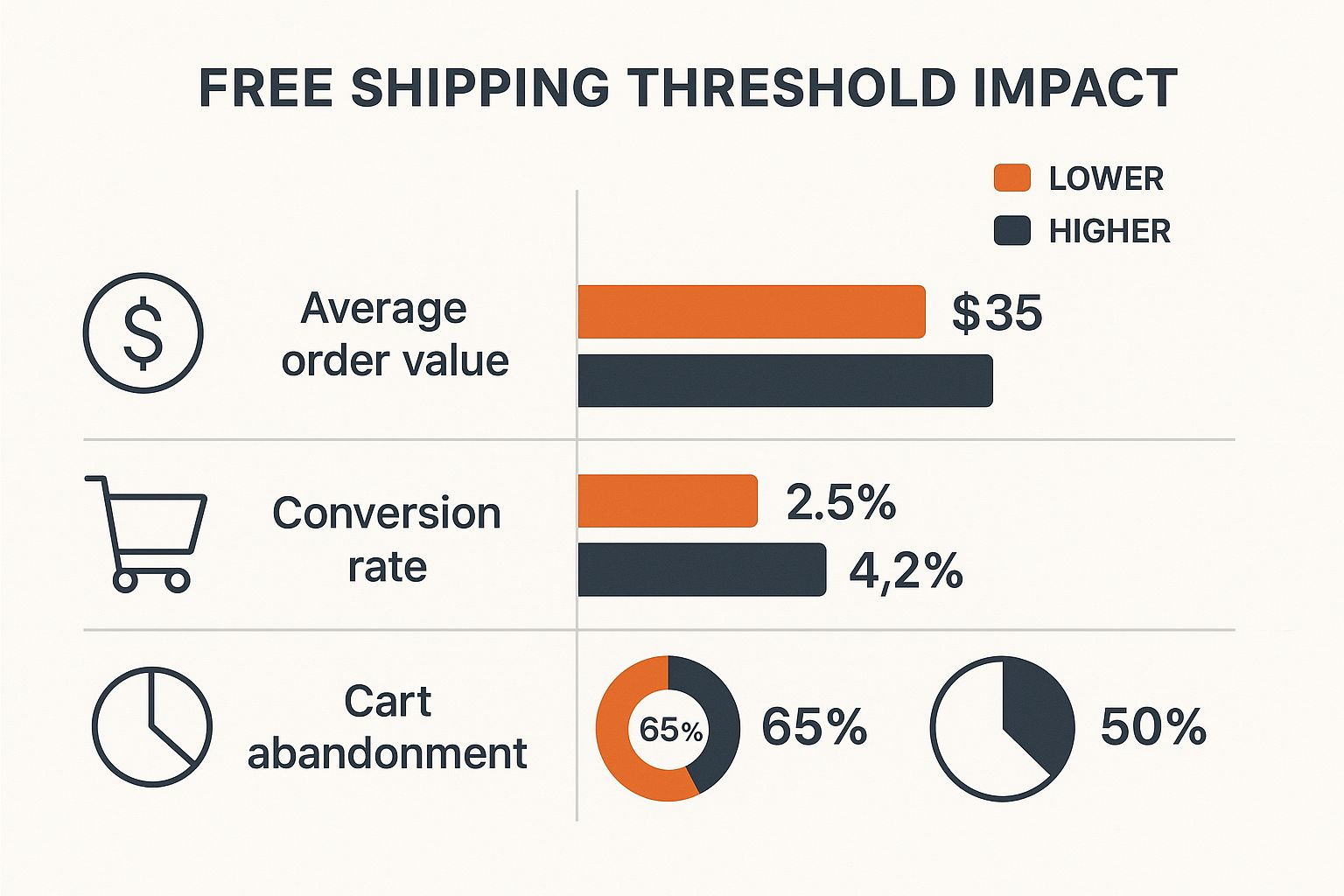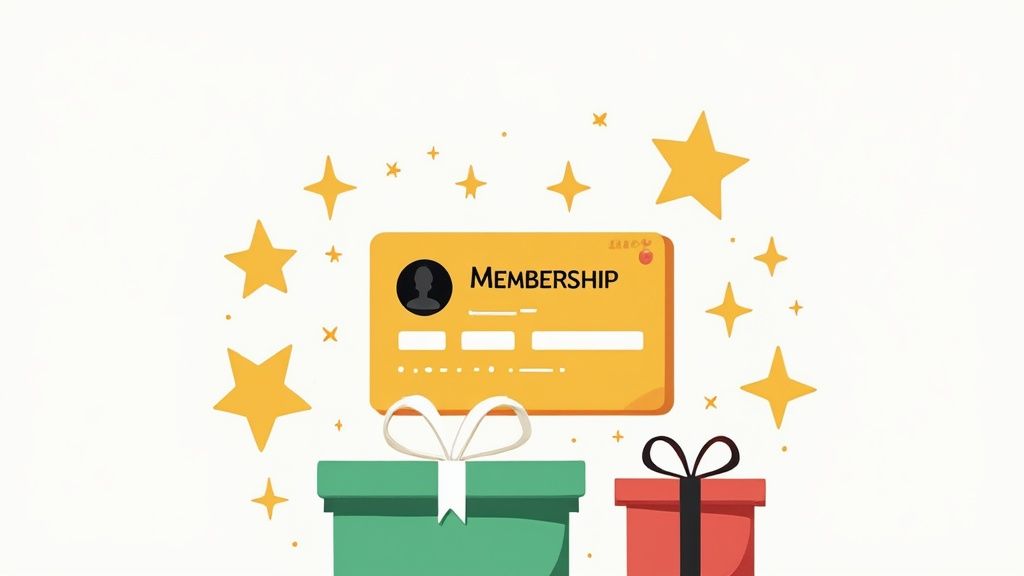How to Increase Average Order Value: Top Strategies
Getting customers to spend a little more on each purchase is the core idea behind increasing your average order value (AOV). The math is simple: just divide your Total Revenue by your Number of Orders. But mastering this metric is where the real magic happens for your bottom line, letting you grow profits without constantly chasing new customers.
Why Average Order Value Is a Critical Growth Metric
AOV isn't just another vanity metric to track on your dashboard; it's one of the most powerful levers you can pull for sustainable growth. Every dollar you put into marketing goes further when the sales you generate are bigger. With customer acquisition costs always seeming to creep up, focusing on AOV helps you get the most out of the traffic and customers you already have.
A higher AOV also means healthier profit margins. Think about it—the fixed costs for every transaction (payment processing, packaging, labor) get spread across a larger sale. That means more profit from each order, which you can then reinvest back into the business.
The Real Impact on Your Business
Boosting your AOV sends positive ripples through your entire operation. When you see a steady rise in order size, it’s usually a great sign that your customers are happy and loyal. Shoppers who trust your brand are far more willing to toss a few extra items into their cart or spring for a higher-end product.
This kind of behavior is a launchpad for improving another key metric: customer lifetime value. We actually dive deeper into that connection in our guide on how to increase customer lifetime value.
Here’s a look at the AOV formula in its simplest form.

As you can see, it's a straightforward calculation—total revenue divided by the number of orders—that tells you exactly what the average customer spends per transaction.
Market Trends Underscore Its Importance
The data doesn't lie: consumers are spending more per transaction. The global average order value has jumped significantly, climbing from around $96 in 2020 to a projected $150–$180 by the end of 2025.
After a small dip at the start of the pandemic, AOV has been on the rise for four years straight. This is partly because more retailers are using tactics like raising free shipping thresholds and getting smarter with upselling. This consistent growth makes it clear that knowing how to increase your AOV isn't just a nice-to-have skill anymore—it's essential for staying competitive. You can dig into more of these e-commerce benchmarks from SpeedCommerce to see the trends for yourself.
Understanding your AOV gives you a baseline for growth. It’s not about tricking customers into spending more; it's about presenting them with more value in a way that benefits both them and your business.
Smart Upsells and Cross-Sells That Actually Work

Upselling and cross-selling are, without a doubt, two of the quickest ways to bump up your average order value. But here's the catch: they only work if you do them right. The secret is to make your offers feel like genuinely helpful suggestions, not a pushy sales tactic. You want to enhance their purchase, not just extract more money from their wallet.
Let's break it down. An upsell is when you nudge a customer toward a better, more premium version of what they're already looking at. Think of someone eyeing a 256GB smartphone; you might show them how the 512GB model offers double the storage for "just a little more."
A cross-sell is a bit different. It’s about suggesting a complementary item. If your customer adds a new digital camera to their cart, you'd recommend a memory card or a protective case to go with it.
Relevance is everything. Generic offers get ignored, but a recommendation that feels personal can make all the difference. Your goal is to show the customer you get them by offering something that makes their main purchase even better.
Where and When to Present Your Offers
Timing is critical. The right offer at the right moment can be the difference between a bigger sale and an abandoned cart. You have a few golden opportunities to make your move.
-
On the Product Page: This is your first and best shot. As someone is checking out an item, you can show them a slightly better version (the upsell) or display a "frequently bought together" section (the cross-sell). For example, if they're looking at a standard drip coffee maker, you could highlight a model that comes with a built-in grinder.
-
In the Shopping Cart: Once an item is in the cart, you know their interest is high. This is the perfect spot for small, high-value cross-sells. Someone buying running shoes? A pop-up suggesting a pair of high-performance socks is a no-brainer.
-
During Checkout: You have to be careful here. The last thing you want to do is disrupt the payment process. A subtle "you might also like" section with low-cost, impulse-buy items is the way to go.
-
Post-Purchase: The conversation doesn't end when the payment goes through. A follow-up email or an offer on the "thank you" page can be incredibly powerful. Someone who just bought a laptop is probably in the market for a sleeve or an external monitor, so an email with a special offer a few days later will land perfectly.
Mastering these touchpoints is a core part of any solid https://www.buildwithtoki.com/blog-post/e-commerce-growth-strategy, as it turns single transactions into more valuable, long-term customer relationships.
Let Data Drive Your Recommendations
The most effective upselling and cross-selling strategies aren't based on guesswork—they're driven by data. When you dig into how your customers actually behave, you can move from making generic suggestions to hyper-relevant offers that feel like they were picked just for them.
Start by looking at your own sales data. What are people already buying together? If you find that 70% of customers who buy your best-selling face serum also grab the matching eye cream, that’s not a coincidence. It’s a data-backed cross-sell you should be showing to every single serum buyer.
Next, think about customer segments. A first-time visitor might respond well to seeing your most popular, proven bundles. A loyal, returning customer, on the other hand, might be more interested in a new accessory that pairs perfectly with something they bought six months ago. This shows you're paying attention.
My Two Cents: Don't just push your most expensive products. The best upsells are often small add-ons that make the main product way better. Think batteries for a kid's toy or a special cleaning cloth for a new pair of sunglasses. These little additions add up fast and boost your AOV without giving customers sticker shock.
At the end of the day, smart upselling is about making the customer’s life easier. When you help someone find a better version of a product or the perfect accessory to go with it, you're not just making a bigger sale. You're building trust and giving them a reason to come back.
Creating Irresistible Product Bundles
Product bundling is so much more than a simple "buy one, get one" gimmick. When you get it right, you’re actually making your customer’s life easier. Instead of forcing them to hunt around for everything they need, you’re handing them a complete solution on a silver platter.
Think about it. A customer could track down a quality coffee grinder, then search for the right beans, and finally look for filters. Or, you could package it all together as a "Complete Coffee Lover's Set" with a small discount. It’s convenient for them and naturally bumps up their cart size. Win-win.
Pure vs. Mixed Bundling: Which One Makes Sense for You?
Not all bundles are created equal. The strategy you pick really depends on your products and what you're trying to achieve. The two main flavors are pure and mixed bundling, and they each have their place.
-
Pure Bundling: This is where you sell a group of products only as a package. A customer can't buy the items separately. This is a bold move, but it works brilliantly for products that are exponentially more valuable together, like a gaming console that’s only sold with its essential controllers and a launch title.
-
Mixed Bundling: This is the go-to for most online stores because of its flexibility. You sell the products individually, but you also offer them as a discounted package. A skincare brand might sell its cleanser, serum, and moisturizer separately, but also offer a "Morning Routine Kit" that bundles all three for 15% off the total price. This gives customers a choice but makes the bundle incredibly tempting.
For most e-commerce businesses, mixed bundling is the smartest way to start. It nudges customers toward a higher spend without frustrating those who just want to grab a single item.
Use Your Data to Build Bundles That Actually Sell
The best bundles aren't just random products thrown together. They're built on cold, hard data about what your customers are already doing. Your own sales history is a goldmine.
Dive into your analytics and look for "frequently bought together" patterns. If you see that 60% of customers who buy your best-selling yoga mat also grab a set of resistance bands, that’s your sign. You've just found a data-backed reason to create a "Yoga Starter Kit." Your offer is no longer a shot in the dark; it's a thoughtful suggestion that shows you get what your customer needs.
This data-driven approach is what separates a wildly successful bundling strategy from a flop. You're creating offers that feel genuinely helpful.
Key Takeaway: Stop guessing what you want to sell together and start looking at what your customers are already buying together. Your transaction history is the best focus group you could ever ask for. Use it to build bundles that feel intuitive and irresistible.
To help you decide where to focus your efforts, here’s a quick comparison of common strategies for increasing your AOV.
Comparing AOV Boosting Strategies
This table breaks down some of the most effective tactics, their typical impact, and where they work best. It’s a good starting point for figuring out what will give you the most bang for your buck.
| Strategy | Typical AOV Lift | Best For | Implementation Effort |
|---|---|---|---|
| Product Bundling | 5-20% | Stores with complementary products (e.g., fashion, electronics, beauty). | Medium |
| Cross-Sells/Upsells | 10-30% | Businesses with tiered products or a wide range of accessories. | Medium to High |
| Free Shipping Threshold | 5-15% | Nearly any e-commerce store with physical products. | Low |
| Loyalty Programs | 5-10% | Brands focused on customer retention and repeat purchases. | High |
| Volume Discounts | 10-25% | Stores selling consumables or items bought in multiples. | Low |
Each of these methods has its strengths. Free shipping thresholds are an easy win for almost anyone, while loyalty programs are a longer-term play that requires more setup. Bundling hits that sweet spot of moderate effort for a solid return.
The image below shows just how powerful a simple incentive like a free shipping threshold can be for your key metrics.

As you can see, encouraging customers to spend just a little bit more doesn't just lift your AOV. It can also have a fantastic ripple effect, boosting your conversion rate and slashing cart abandonment.
Setting a Strategic Free Shipping Threshold

The promise of “free shipping” is pure gold in e-commerce. I’ve seen it time and again: it’s the one thing that can single-handedly convince a customer to toss just one more item into their cart, turning a decent sale into a fantastic one.
The real trick, though, is setting that threshold just right. You want to encourage bigger orders without making shoppers feel like the goal is out of reach or, worse, eating into your own profits. A well-placed free shipping minimum doesn't just bump up your average order value; it's also a massive driver for conversion rates. When people see they’re just a few dollars away from a real reward, they’re much more likely to follow through and check out.
Calculating Your Ideal Threshold
Figuring out the magic number isn't about pulling a figure out of thin air. The smartest way to do this is by digging into your own sales data. But here's a pro tip: don't just look at your overall average order value (AOV). A few unusually large orders can easily skew that number.
Instead, zero in on your modal order value—that's the order amount that shows up most frequently in your reports.
Let’s say your AOV is $65, but you notice that the vast majority of your customers are actually spending around $45 (your modal value). If you set your free shipping threshold at $75, it's going to feel like a huge leap for most people. A much better approach would be to set it just above that common $45 mark, maybe at $50 or $55. Suddenly, the goal feels totally achievable.
A solid rule of thumb is to aim for a free shipping minimum that's about 15-20% higher than your modal order value. That slight bump is often all it takes to get someone to add a small, extra item to their cart.
Your goal isn't to force a massive purchase; it's to make adding one more small item feel like a smart, value-driven decision for the customer.
Making Your Offer Impossible to Miss
Once you’ve landed on your threshold, you need to shout it from the rooftops. If customers don't see the offer, they can't act on it. Visibility is everything.
- Website Banners: Slap a prominent banner right at the top of your site. Something clear and simple like, "Free Shipping on All Orders Over $50!" sets the expectation the second someone lands on your page.
- Cart Notifications: This is where you can get clever. Use dynamic messaging right in the shopping cart. A little progress bar that says, "You're only $12 away from free shipping!" gamifies the experience and gives a crystal-clear call to action.
- Product Page Reminders: On your product pages, especially for lower-priced items that make perfect cart-fillers, add a subtle note. A quick "Add this to your order to help you qualify for free shipping" can work wonders.
Exploring Alternatives to Free Shipping
While free shipping is the undisputed classic, it’s not the only play in the book. Sometimes, a different kind of reward can be more exciting for the customer and more cost-effective for your business.
Why not try one of these?
- Offer a Free Gift: Set a spending minimum to unlock a free product. This makes the order feel more valuable and is a great way to introduce customers to other items they might love.
- Provide a Future Discount: For orders over a certain amount, email them a coupon for a future purchase, like 15% off their next order. This not only boosts the current AOV but also gives them a great reason to come back.
Marketplace trends definitely play a role here. For instance, Amazon's AOV was reported to be a stable $52 in 2024–2025, a number that reflects its enormous scale. Direct-to-consumer brands, on the other hand, have the flexibility to experiment with these kinds of personalized incentives and often see significant lifts in AOV. You can get more context on these marketplace AOV dynamics from Red Stag Fulfillment.
Ultimately, the key is to make the reward feel more valuable than the extra cash they're spending to get it.
Designing a Loyalty Program That Rewards Spending
Let's be honest, your best customers are the lifeblood of your business. They're the ones who come back time and again, and a smart rewards program is one of the best ways to thank them—and encourage them to spend a little more. A simple points-for-every-dollar system is fine, but if you really want to move the needle on your average order value, you need to get more strategic.
The idea is to build a system that goes beyond just a basic transaction. When shoppers feel like their loyalty is genuinely valued, and they know bigger purchases unlock better perks, they have a real incentive to stick with you instead of browsing your competitors.
Go Beyond Basic Points with Tiered Rewards
This is where things get fun. A tiered loyalty program turns shopping into a bit of a game and shows customers a clear roadmap to getting more value from your brand. Instead of a one-size-fits-all rewards rate, customers unlock better and better benefits as they spend more. It’s the perfect way to give your top customers the VIP treatment they’ve earned.
Think of it like a club with different levels—maybe Bronze, Silver, and Gold.
- Bronze Tier (Entry-Level): This is the welcome mat. New members might get a small discount on their next purchase and earn a standard number of points for every dollar they spend.
- Silver Tier (Mid-Level Spenders): Once a customer hits a specific spending milestone, they level up. Now they get perks like early access to new arrivals or special bonus point days.
- Gold Tier (Top Spenders): These are your all-stars. Reward them with things that really matter, like free shipping on every order, exclusive access to limited-edition products, or even a personal customer service contact.
This structure creates a powerful sense of aspiration. A customer sitting in the Silver tier can see the exclusive Gold benefits right there, motivating them to make that extra purchase to level up. For a deeper dive, check out our guide on how to create a rewards program that really connects with your customers.
Personalize Offers to Deepen Relationships
Your loyalty program isn't just about giving out points; it's a treasure trove of data. You have a direct line of sight into what your best customers are buying and how often they're buying it. Put that information to work by sending out personalized offers that prove you're paying attention.
For example, if you know a loyal customer always buys your brand's running shoes, don't just send them a generic 10% off coupon. Instead, a targeted email letting them know a new model just dropped—maybe with an exclusive offer just for them—feels personal and incredibly valuable.
Expert Insight: I've seen brands have huge success using purchase history to gently nudge loyal customers toward higher-value products. If someone consistently buys your entry-level skincare line, create an exclusive bundle that lets them try your premium collection for a small discount. This isn't just about boosting their AOV this one time—it's about upgrading their future spending habits for good.
That kind of personalization makes customers feel seen and understood, strengthening their connection to your brand and encouraging them to explore everything you have to offer.
The Proven Value of Retaining Customers
When it comes down to it, focusing on the customers you already have is one of the most dependable ways to increase your average order value. The data doesn't lie: repeat buyers consistently outperform new ones. Take the online grocery sector, for instance, where consumer behavior analysis revealed a pretty significant spending gap.
The average order value for a first-time online grocery shopper in the U.S. was $81 back in January 2025. But for a fourth-time buyer? That number shot up to $118. This 25% difference is a clear signal that investing in customer retention directly leads to bigger shopping carts and healthier revenue. You can dig into more of this data over at Statista's consumer behavior report.
Ultimately, a loyalty program designed to reward higher spending does so much more than just bump up a single metric. It helps turn casual shoppers into true brand advocates who not only spend more with each purchase but keep coming back for more.
Got Questions About Boosting Your AOV? We've Got Answers.
As you start exploring ways to increase your average order value, a few common questions always seem to pop up. It's smart to think these through. Getting them answered upfront helps you build a strategy that actually grows your revenue without backfiring.
Let's break down some of the things ecommerce owners worry about most.
What Is a Good Average Order Value to Aim For?
Honestly? There's no magic number. A "good" AOV is completely relative to your own store.
It’s tempting to look at industry benchmarks, but comparing a high-end furniture store to a shop that sells phone cases just doesn't make sense. Their price points and customer behaviors are worlds apart.
The only benchmark that truly matters is your own. Look at your historical data and aim for steady, incremental improvement. A 10-15% increase in a quarter is a fantastic result. The goal is to consistently beat your own last record, not some arbitrary industry standard.
How Quickly Will I See Results from These Strategies?
This really depends on the tactic you choose. Some moves pay off almost immediately, while others are more of a long game.
You can break it down into two camps:
-
Quick Wins (Think Weeks): Things like adding a free shipping threshold or a "customers also bought" section on your product pages can show results fast. These are low-effort changes that can give you a nice, quick lift.
-
Long-Term Plays (Think Months): Bigger projects, like rolling out a tiered loyalty program or setting up sophisticated product recommendations, take more time. You need to plan, implement, and then gather enough data to see the full impact.
My advice? Start with the low-hanging fruit to get some momentum. While those quick wins are rolling in, you can start planning the bigger, more impactful projects for the months ahead.
It's a valid concern—if your tactics are too aggressive, you can absolutely harm your conversion rate. An impossibly high shipping threshold or an endless stream of annoying pop-ups will send customers running.
Can Trying to Increase AOV Hurt My Conversion Rate?
Yes, it absolutely can—if you do it wrong. This is probably the most critical question of all.
The golden rule here is to add value, not friction. A well-timed upsell should feel like a genuinely helpful suggestion. A free shipping threshold should feel like a reasonable, achievable goal, not a cash grab.
The only way to know for sure is to test everything. A/B test your shipping thresholds, your bundle offers, and your pop-ups to find that sweet spot. You're looking for the point where you get the highest AOV without making people abandon their carts in frustration.
Keep a close eye on both AOV and your conversion rate. Sometimes, a tiny dip in conversions is a worthwhile trade-off for a significant jump in AOV that leads to more overall profit. It's all about finding that perfect balance for your business.
Ready to turn casual shoppers into brand champions? Toki provides all the tools you need—from tiered loyalty programs to referral systems—to boost customer engagement and drive repeat sales. Start building lasting relationships today at https://buildwithtoki.com.